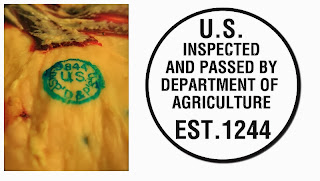When meat is evaluated for safety and wholesomeness, it
either passes and is sold for human
consumption or it fails and cannot
be sold for human consumption. Pass or
fail: there is no middle ground.
To be legally sold in the US, meat must be inspected
by a USDA inspector. In some states (27), if the meat will not cross state
lines for sale, an inspector from a state
inspection agency may inspect the meat. Meat that will be sold across state
lines or exported must be inspected by USDA.
If animals are to be slaughtered, the USDA meat inspectors
must be there and observe the entire process. They have to inspect the live animals
before they are slaughtered. At that point, they qualify as passed, suspect, or
condemned. Animals that are considered ‘suspect’ are held for a time and
reevaluated before they can be passed. Sick and dying animals do not pass inspection. Only healthy
animals that can walk on their own are allowed to be harvested for food.
USDA inspectors observe the slaughter process and make sure
the animals are humanely harvested. The animal is required by law to be stunned and rendered insensitive to pain, before the
animal dies by massive blood loss that it does not feel. Dr. Temple Grandin has made it her life’s
work to ensure that animals are handled and slaughtered humanely in meat
processing plants. Meat companies use her methods and advice for humane
handling in the plant and humane slaughter. If you are interested, she has made
videos of
humane stunning of beef and pork that you can watch.
After the animal dies, inspectors observe the entire
slaughter process and will look at the carcass and all of its parts and pieces
to make sure it was truly healthy and is safe to consume. They look at the head
and lymph glands, the heart, lungs, liver and other internal organs. They make
sure the carcass is clean and was not contaminated during the slaughter
process. I have a blog post about all the steps in the slaughter
process that help to make sure the carcass stays as clean as possible.
Once the slaughter process is complete, the inspector will
declare each carcass as pass, retain, or condemn. Animals that need further
diagnosis are held in a locked area of the plant. They are “retained” for further testing. Any carcasses
that are condemned are deemed inedible and removed from the food supply.
Carcasses that pass inspection are stamped with a purple,
edible ink. This stamp will contain a number that corresponds with the plant where
the animal was slaughtered. These are called ‘establishment
numbers.’ Each USDA-inspected meat processing facility has a unique number
given to them by USDA. These are for slaughter and processing plants. You can
visit the establishment number page on the USDA website and find where a
particular item was processed, or you can look up the numbers of plants by
searching where they are located.
 |
| This picture came from Jenny Dewey Rohrich and her blog at Chico Locker and Sausage. |
Beyond slaughter, inspectors work in all types of meat
plants to oversee the daily processes. They may work in the non-slaughter areas
of a slaughter plant or in other types of meat plants that do not slaughter
animals, such as sausage plants or grinding facilities. They watch all the
aspects of production and work to insure that the meat is processed in a safe
manner. They may check temperatures of meat or production rooms, make sure
everything is stored properly, watch that employees follow all the food safety
regulations, take samples of meat or food contact surfaces for pathogen
testing, or check that all the food safety paperwork is filled out correctly.
Side note: Inspectors work for the US government and are
paid with tax-payer dollars for their 40-hour week. If they work overtime, the
companies have to pay for their hours. Many of them work in shifts just like
the plant employees do.
A meat product has passed several levels of checking and
rechecking to ensure that it was produced safely and labeled correctly before
it reaches the consumer with its inspection stamp. Any product that has passed
inspection and been stamped or labeled with the USDA inspection stamp is edible
and fit for consumption. If it’s not, it failed.
There is no barely-edible or partially-passed meat under USDA inspection.
Here are a few more resources about meat inspection:

Great post! - Bethany from bestfoodfacts.org
ReplyDeleteThanks so much! Thanks for sharing it!
DeleteNice Post !!! Thanks for sharing !
ReplyDeleteInspecteurs en Batiment
Janeal, my junior and AP English classes have just started reading Upton Sinclair's The Jungle.... may I have your permission to link your blog to my website and use your info in class?
ReplyDeleteThis comment has been removed by a blog administrator.
ReplyDeleteThe meat industry wants to regulate itself:
ReplyDeletehttp://voices.yahoo.com/slaughterhouses-self-regulation-12153761.html?cat=5
Nice Post !!! Thanks for sharing
ReplyDelete